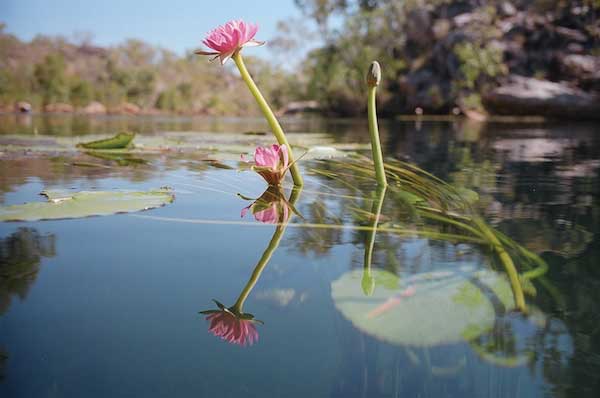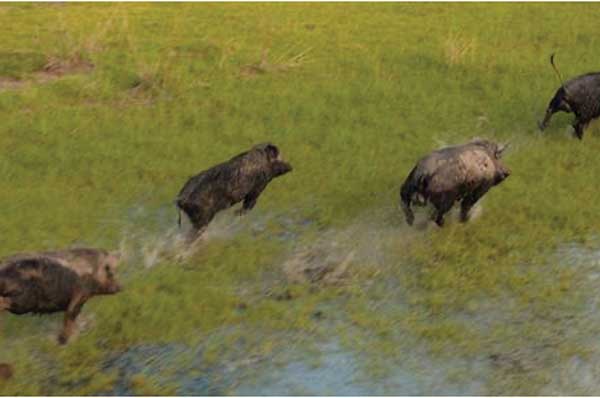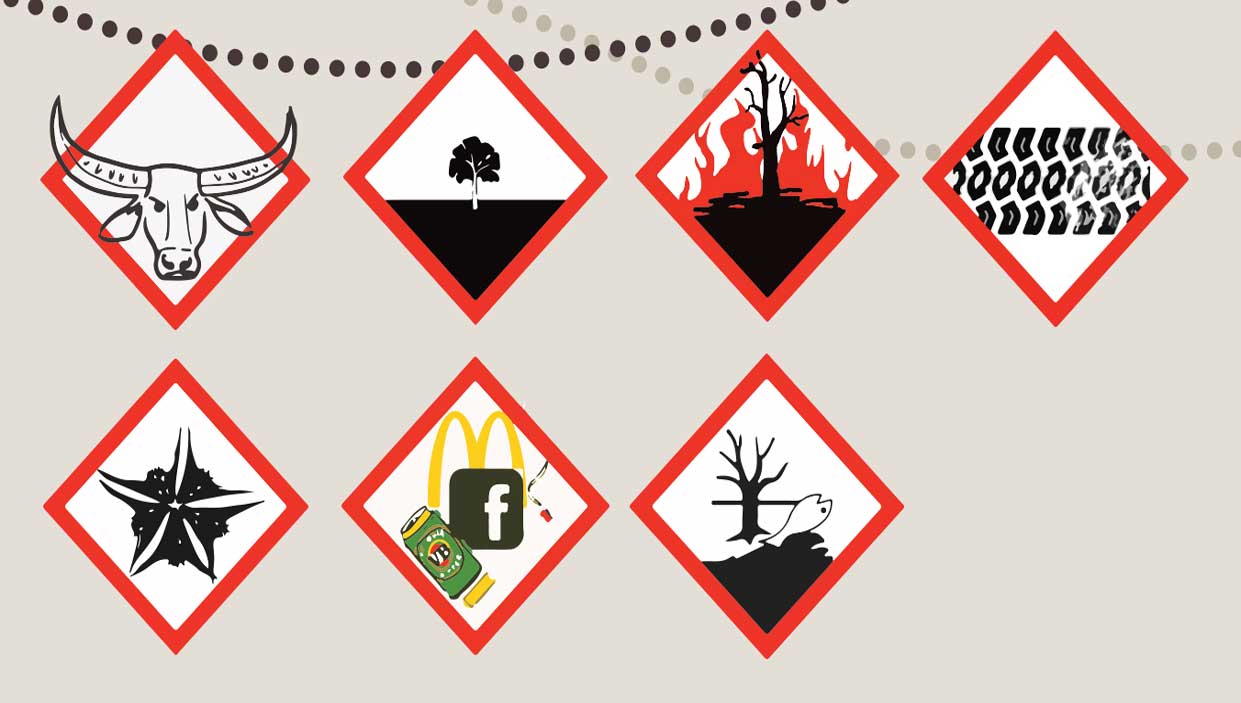Our Country
Jawoyn country is a place where our stories are told and our ancestors belong, where vast landscapes of sandstone gorges, cascading waterfalls and rocky outcrops, hold and evoke our dreaming.
It’s a land that has sustained life for millennia, incorporating a diversity of plants and animals from the stone country to the river plains.
Dotted across our land are our communities as well as special places for culture and ceremony.
Our Land
Jawoyn traditional land stretches across 55,000 square kilometres.
It extends north-west from the town of Katherine to Pine Creek, makes a north-east arc crossing the southern part of Kakadu National Park and Arnhem Land to the west of Bulman, then returns south-west to Mataranka and up to Katherine.
A large majority of our traditional land has been handed back to us since the introduction of Aboriginal land rights and native title legislation.
Since we won our first land claim of Nitmiluk in 1989, we have become the recognised traditional owners in the Katherine region, western Arnhem Land and the southern area of Kakadu National Park.
Jawoyn Rangers
Jawoyn Rangers are one of our great success stories.
Community, culture and country lay at the heart of our work.
The rangers have been caring for country, by incorporating traditional values and culture with the latest in scientific practice, since the late 1990s.
The ranger program is a successful model to achieving our broader core values of managing country effectively, building employment and education opportunities, and protecting cultural sites of significance.
Operating out of Jawoyn headquarters in Katherine, we have 10 permanent rangers supported by a full-time coordinator. In the high season, there are more than 40 rangers working on our programs.
Mangarrayi Rangers
Mangarrayi Rangers and Jawoyn Rangers have joined forces to manage country.
Established almost a decade ago, the Mangarrayi Rangers manage land, water and fire in the Roper River area, about 150 kilometres south-east of Katherine.
The team includes five full-time rangers from Jilkminggan community and nearby areas. They’re responsible for work in the Mangarrayi Aboriginal Land Trust and the Roper River corridor.
The area is home to one of the Northern Territory’s great rivers. Crystal clear waters from the Mataranka, Bitter and Elsey springs aquifer feed the headwaters, as the Roper makes its 250 km journey east to the sea.
Home to the famous barramundi, the river and hot springs at Elsey National Park are a mecca for tourists, fishers, twitchers and bushwalkers.
In addition to land, water and fire management, the team manage and protect sites of cultural significance, which include dreamings and historical associations with numerous water places.
The rangers partner with government agencies to conduct important fish and water monitoring, mammal surveys and tracking, as well as work to reduce weeds and eradicate feral animals such as buffalo, pigs and donkeys.
In recent years, they’ve stepped up their work with authorities to address the number of unwanted, illegal visitors who access land without permission.
In 2018, the Jawoyn Association expanded its ranger program to include the Mangarrayi rangers.
The move came after the rangers called for external support to access much-needed funding and secure their future.
The association will establish a ranger base in early 2019.
The rangers previously operated in association with the Roper River landcare group.
Quality Work
The rangers work with the NT Department of Primary Industry to monitor the salinity, turbidity and water temperature of the Roper River.
They also maintain fish loggers that track around 100 microchipped barramundi.
Land Management
’Caring for Country’ means a spiritual attachment to the land, to creation beings, plants and animals, to the source of rules for living and stories, to dance, songs and art.
In the last 150 years, traditional Indigenous land management practices have been disrupted with the introduction of clearing of land for grazing, agriculture, mining and urban development, alongside the spread of exotic plants and animals.
Since 1985, we have increased our capacity to address these varied issues. We support our ranger group to manage and maintain country to enhance environmental and cultural values and to accommodate sustainable human use. We combine our traditional practices with the latest in natural resource management technology and approaches.
In addition to joint park management of Nitmiluk and Kakadu National Parks, we use our traditional practices of burning small fires across country to reduce the impact of wildfires and we work to minimise the environmental devastation caused by feral animals and weeds.
Feral Animal & Weed Control
The ever-increasing number of feral animals is considered one of the main threats to biological diversity in northern Australia.
The presence of weeds also creates major problems for native plants and animals. Some choke waterways, others burn so hot they destroy flora designed to withstand a certain amount of fire.
Feral animals – including buffalo, cattle, horses, donkeys, pigs, cats, wild dogs and cane toads – cause the spread of exotic weeds and disease, displace native animals, compete for food and sometimes threaten the safety of people. They also damage important art sites, sacred sites and ceremony grounds.
For this reason, we actively manage feral animals with regular mustering and aerial shoots. Where feral animals are accessible and can be harvested, they also provide food for local communities and economic benefits through recreational hunting.
Jawoyn country has a large number of endangered and vulnerable animals and birds, such as the Gouldian Finch, the Crested Shrike Tit, the Hooded Parrot, the Emu and at least seven plant species of Boronias.
Parks Management

Nitmiluk National Park
Jawoyn jointly manage Nitmiluk National Park with the Northern Territory Government. It was the first of its type in the nation and has been heralded as a model of joint-management for other areas. Nominated representatives are members of the Nitmiluk National Park management board.

Kakadu National Park
South Kakadu National Park is recognised as Jawoyn traditional lands, taking in the popular sites of Gunlom and Barramundi Gorge. Nominated representatives are members of the Kakadu National Park management board.
Fire Management
For tens of thousands of years, our ancestors used fire to hunt, cook and to regenerate the land.
Northern Australia’s tropical savanna is one of the most fire prone landscapes in the world.
Our ancestors managed savanna areas through deliberate and skilful fire management – as the wet season subsided and vegetation began to dry, they strategically burned areas to protect the country from wildfire.
After colonisation, this fire management regime became neglected and huge uncontrollable wildfires swept across the land – and damaging everything in their path.
But thanks to carbon for savanna fire management, we are reclaiming proper fire management for Jawoyn land.
Today, we employ the same techniques as our ancestors – burning areas in the early dry season to reduce wildfires and refresh country. But we also use the latest in modern technology to plan and strategically manage fire.
Jawoyn Rangers conduct aerial and on-ground burning to prevent late season wildfires and reduce overall carbon emissions.
Jawoyn Fire Project
The Jawoyn Fire Project is an Australian government- approved project that recognises the carbon credits we produce by reducing wildfires and greenhouse gas emissions through strategic, controlled savanna burning.
The fire project’s benefits reach far and wide. It reduces harmful emissions, protects important wildlife and delivers significant social, cultural and economic benefits.
We offer a certified environmental offsets service that enables individuals and organisations to offset carbon emissions from their activities and events.
Jawoyn Fire Project
The Jawoyn Fire Project is an Australian government-approved project that recognizes the carbon credits we produce by reducing wildfires and greenhouse gas emissions through strategic, controlled savanna burning.
History
Jawoyn were an early participant in carbon economy.
Together with four other Arnhem Land ranger groups – Wardekken, Mimal, Djelk and Ardjamarlarl – we contributed to the successful West Arnhem Land Fire Abatement (WALFA) project, which pioneered the savanna burning approach to emissions reduction.
Healthy Country
A Healthy Country is a place where our cultural sites, plants and animals and water places are thriving and cared for.
The Jawoyn Association has developed a Healthy Country Plan as a practical and community-owned guide for all major land management and cultural activities on Jawoyn country.
The plan has to come from the dreams, concerns and knowledge of the Jawoyn people. It is being used to guide the association’s work, direct the Jawoyn Rangers and the Banatjarl Strongbala Wimun Grup and to engage with government agencies and stakeholders in cultural and environmental management.
In addition, it will guide land use negotiations and decision makers when considering the future of economic development across Jawoyn country.
Planning Process
The planning process for the Healthy Country Plan involved three large community consultations, which kicked off in September 2016.
The working group which included Jawoyn Rangers, two external experts and a healthy country coach. At each consultation, two people were elected to form part of steering committee.
This same working group compiled the mass of information to form the Healthy Country Plan. The steering committee met frequently to guide the direction of the plan and ensure its integrity.

Values
The areas that people care most about have been classified as values, which have measurable goals of things we want to see into the future.
They include:
Living Culture, Cultural Sites and Rock Art, Important Plants, Important Animals, Water Places, Fire Management, Getting on Country

Threats
We identified the main problems affecting our country and communities and values and have called these threats.
They include: Feral Animals, Lonely Country, Bad Fire Practices, Wrong People on Country, Weeds, Distractions and Unhealthy Lifestyle, Development Pressure
We classified these into seven main areas and prioritised these threats with in a threat/value matrix.

